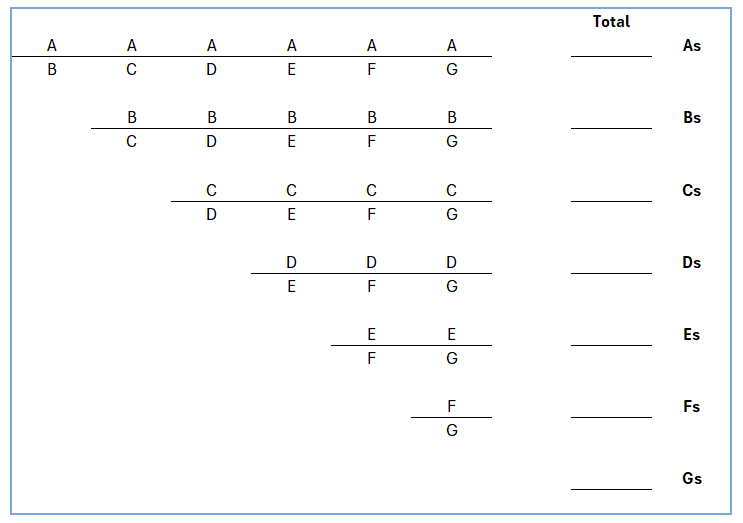Defining Your Core Values (The Compass)
Part 2 in "Charting Your Path: A Guide to a Meaningful Life"
Strong core values can change your life. They keep you grounded when everything around you feels chaotic, and they give you clarity when the right path is unclear.
The problem is that most of the core values we're exposed to are not very good, so we underestimate the impact they can have.
To me, good core values meet three main criteria:
They are never one word. They are phrases or short-sentences, often action-oriented.
They are never generic. They’re unique to me and immediately trigger a reminder of how I want to live day-to-day.
They are useful. (Because of numbers 1 and 2)
As an example, my primary core value is “Focus on what you can control.” I could’ve just said “Focus”, but when I’m in crisis mode or dealing with tough decisions, that doesn’t help me much.
What does help me is to remember to focus on what I can control. This one simple phrase drives 99% of my mental strength.1
That’s a big statement. Such is the power of good core values.
I realize this may be a different portrayal of core values than you’re used to. It is different because I only care about one thing here: making them useful.
So, how do we determine our core values?
1. Start Simple - Brainstorm One-Word Prompts
Sometimes it’s easier to warm up by starting with simple words before diving deeper. In this step, we’re not aiming for perfect answers - just quick, gut-level reactions to get the ideas flowing.
Think about what qualities matter most to you - words that describe how you want to live or what you want to stand for.
Write down 10 words that feel important. Don’t overthink it - just jot down what comes to mind.
If you need some ideas, you can check out James Clear’s list of core values to see some examples. Resist this at first, though - just write.
2. Reflect - When Have You Felt Most True to Yourself?
Now that you’ve brainstormed some ideas, let’s clarify what they mean to you by grounding them in real experiences.
Look at your list from Step 1. Which words feel connected to moments when you’ve been at your best - or moments when something felt off?
Reflection Questions
Proud Moment: When was a time you felt calm, confident, and proud of how you handled a tough situation? What values showed up in that moment?
Regretful Moment: When was a time you felt uneasy about your actions? What value might have been missing or compromised?
Write down the patterns, themes, or connections you notice between these moments and your brainstormed words.
The goal here is to refine or expand your initial list so you’re ready to prioritize in the next step.
Tip: If you’re struggling with this, evaluate how you’ve made big decisions in your life (career moves, relationships, etc.) and write down the principles guiding those choices.
3. Narrow Your List & Prioritize
The purpose of understanding your core values is to help you in make decisions in everyday life. The goal is simplicity - values you can remember and use.
So let’s simplify:
1. Based on Steps 1 & 2, write down the seven core values that resonate the most. Example: balance, courage, humility, discipline, love, authenticity, growth
2. Rank by importance. Compare them in pairs - if you had to pick one over the other, which one wins? Keep doing this until you have a prioritized list.
3. Pick 3-5 values that truly capture who you are and how you want to live. Ask yourself, “If I lived by these values, would I be proud of my choices?”
This step can feel tedious, but it is critical and enlightening. I was surprised at my own rankings when I went through it. Don’t skip this.
Below is a simple graphic you can use to easily compare values.

4. Make Them Useful - Memorable, Actionable Phrases
The next step is to translate your values into phrases that are clear and actionable.
Rather than vague, one-word values like “Integrity” or “Courage”, our aim is to create short, memorable statements that help guide daily decisions.
Examples:
Instead of “Focus”, I use “Focus on what you can control”
Instead of “Courage”, I use “Do not dwell in fear”
Instead of “Love”, I use “Love by being present”
Instead of “Action”, I use “Be quick, but don’t hurry”2
These phrases don’t perfectly translate to one word values, but that’s precisely the point! Real values are much more nuanced than one word can easily convey.
For example, “Be quick, but don’t hurry” encapsulates my values of action and urgency, while also balancing temperance and mindfulness.
Now, your turn:
Take each of your 3-5 values and ask: What does this really mean to me?
Then, turn each into a memorable, actionable phrase.
Test your phrases:
Would this help me make a tough decision in real time?
Does it remind me how I want to act - not just what I value?
Tip: My wife Callie has another way of thinking about this, which I find inspiring. Frame the question as, “I want to be the kind of person who. . .” and see what comes up.
For example, she said: “I want to be the kind of person someone feels comfortable sitting next to at church for the first time.” To me, that beautifully captures values like kindness, empathy, and inclusivity.
5. Reality Check - Actual vs. Aspirational Values
The core values you now have give you clear tools for daily decisions. The final step is to evaluate how well these align with your current life and identify areas for growth.
Separate your values into two categories: Actual vs. Aspirational
Actual Values - qualities you consistently embody
Aspirational Values - qualities you admire and want to grow into
It’s impossible to live into your values 100% of the time, but we know when a value is more aspirational than actual.
For me personally, the value around “focusing on what I can control” is rock solid - but the value around active love and being present is a work-in-progress.
That’s ok! We are all a work-in-progress, and aspirational values serve as good guideposts for growth (which we will tackle in Part 4 on initiatives). The important part is that you are aware of both who you are and who you want to be.
Wrapping Up: Tie It Back to Your North Star
Your North Star is the direction you’re headed and your Core Values are the compass that keeps you on track.
Even when times are tough or decisions are unclear, your values point the way forward.
I focus on what I can control, I don’t dwell on fear, I love others by being present, and I am quick but not hurried.
A final word of advice: don’t force these. Take your time. Good core values are very personal. Don’t rush it - keep thinking on it, pay attention to yourself, and see what becomes useful over time.
In the next section, we’ll identify the areas of your life that deserve the most focus. By aligning your values with your priorities - the key checkpoints on your journey - you’ll ensure that your time and energy are spent on what truly matters, bringing you closer to your North Star.
Next Section: Setting Your Priorities (The Bridge)
While this concept appears in many religions, philosophies, and ideologies, it first took hold in me after reading Meditations by Marcus Aurelius many years ago.
Based on the quote from legendary basketball coach John Wooden, which I first heard from sports mindfulness & performance coach George Mumford





Thank you Peter, that was a great article and a very interesting exercise (which took me a few days and iteration to complete).
I landed on:
Internal honesty
Doing Good
Ambition
I feel strongly about them, and have in my mind what it means, but struggled to translate to sentences. This is what I came up with:
Doing good - I improve lives through my actions (not chasing quick money, not working on things that will hurt or not benefit other humans)
Internal Honesty - I behave authentically (I wanted to add about speaking the truth, but I feel it's very hard for me to measure up to that. Not always being nice and saying 'white lies'. The point is to listen within and do the things I want and believe in, and not be guided by pleasing others).
Ambition - I aim higher than is reasonable.
“They are never one word” - such a simple but practical rule, and I feel like this is pretty counter to most of the examples you see. Love it!